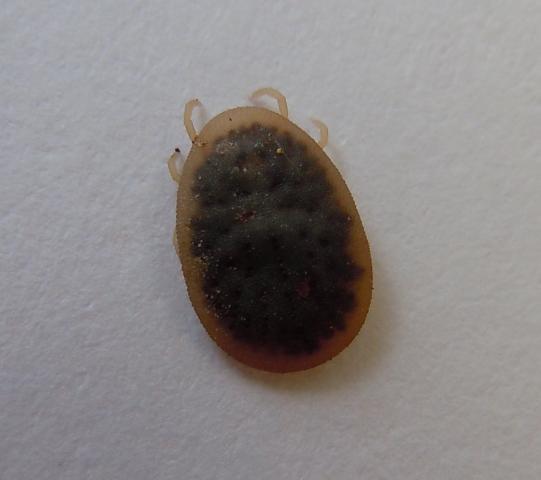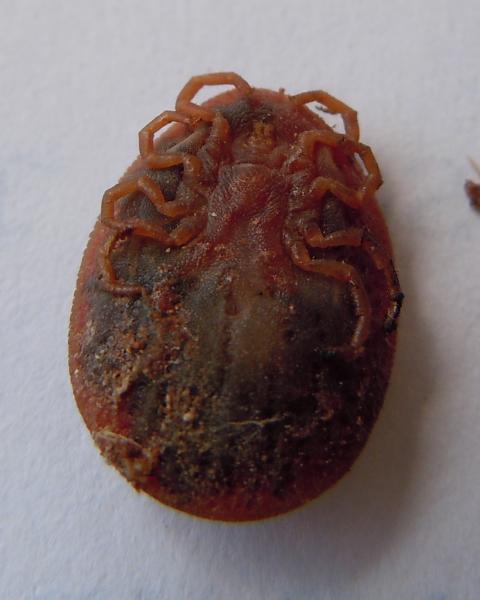When I woke up this morning I had never heard of poultry ticks. I had been worried about a 9 month old BO that was loosing feathers. I'd been checking each bird weekly for parasites but had found none. This morning I decided to examine the coop closely to see if there were any suspicious bugs in there. I immediately found insect exoskeletons in the spider webs below the roosts and traced them to the crevice between the top two boards of my coop, immediately below the roosting area. I stuck my putty knife in the crevice and it came out covered in blood. At first I thought they were bed bugs. It fit the pattern of moving onto the prey at night and hiding in crevices below during the day. After I was able to photograph it and look at it with my glasses on I realized it wasn't a bed bug, but something else. I sent the pics off to the local guy (University of AZ Entomology) who knows all about bugs and he immediately responded that they were a member of the soft-bodied ticks (Argasidae) Argas persicus. I then spoke with the great folks at the University of Arizona Veterinary Diagnostics Lab. and they said they were very common all along the southern tier of the U.S. Most people may never realize they have them because they feed at night and hide during he day. I certainly had never heard of a tick that fed repeatedly like they do. He also said they are transported by wild birds. They suggested pyrethroids or organophosphates for control.
Here are the buggers:


By the time I figured out what they were, it was too late to do anything about them but I could learn as much as possible. Tonight I got into the coop at 6:40 pm, just about 10 min. after sunset. I scanned the entire coop continuously for three hours. I immediately spotted ticks on the wood parts of the roosts and moving out of the crevice. I killed 44 in the first hour and a half. In three hours I killed a total of 51 (almost none in the last half-hour). Here's what they do: I think they're waiting on the boards right at sunset when the birds come inside to roost (I missed this part). They quickly get onto the birds and over the next half hour to hour they crawl out of the crevice and try to get onto a bird. They feed for about 30 min. or so and then jump off the bird. Many, if not most of the ticks fall the 7'+ distance to the ground because most of the birds are now over the wire and not on the wood of the roost (my birds roost on wire). I put a white pillow case on the floor below the birds and could easily see them when they fell. They then crawl up the wall and back to the crevice. Most of the ticks (about 35) were found on the 2X4 immediately below the birds and had just come out of the crevice below that first board and were apparently seeking a bird. All of the ticks were found within 2' laterally of the birds and below. Most were found on the board the birds were standing on to get to the wire part of the roost. I found no ticks in any other part of the coop, run, nest boxes, feeders or places they like to dust bathe. The ticks that fell to the ground were not guaranteed safe return to the crevice. I saw several ticks killed by ground-dwelling spiders, ant lions and web building spiders. Some had fallen directly into the web and were eaten by the spiders below the chickens.
I've done some reading about these beasts and through my conversations with the experts, it seems that eliminating the crevice is crucial to controlling them. It sounds like they can't survive there without it. Tomorrow I'll seal up every crevice in the coop with DAP 230 clear sealant. The bad news about these guys is they can carry all sorts of poultry disease.
Here is a short description I found on the UC Davis Entomology web site about Poultry ticks (Argus persicus and A. sanchezi):
These ticks are common pests of chickens and turkeys, but generally do not cause serious problems except for small flocks on farms which provide wooden housing that encourages tick establishment. Eggs are laid in crevices in the wood. All stages of these ticks remain around the roosting area of poultry, hiding in crevices during the day and generally feeding at night. Ticks can survive in empty poultry housing for years. Argas sanchezi is a common tick of chickens, turkeys, and wild birds in California and other western states. In California it is primarily found in central valley dry climates from Shasta down to Kern county, as well as the dry coastal and inland southern California regions. Argas persicus infests chickens mostly in the eastern U.S., and only rarely has been collected in California in Nevada county (Furman and Loomis 1984).
I did some searches on BYC today and found some confusion about ticks out there. Apparently chickens eat a lot of ticks, but this particular tick usually evades their predatory abilities by feeding on the bird at night and hiding from them during the day. Their particularly creepy habit of sucking blood right after nightfall and hiding in crevices during the day make them all the more difficult for us to observe. I think a lot of people have had them, but never knew what they were. I hope this helps someone else out there.
Here are the buggers:


By the time I figured out what they were, it was too late to do anything about them but I could learn as much as possible. Tonight I got into the coop at 6:40 pm, just about 10 min. after sunset. I scanned the entire coop continuously for three hours. I immediately spotted ticks on the wood parts of the roosts and moving out of the crevice. I killed 44 in the first hour and a half. In three hours I killed a total of 51 (almost none in the last half-hour). Here's what they do: I think they're waiting on the boards right at sunset when the birds come inside to roost (I missed this part). They quickly get onto the birds and over the next half hour to hour they crawl out of the crevice and try to get onto a bird. They feed for about 30 min. or so and then jump off the bird. Many, if not most of the ticks fall the 7'+ distance to the ground because most of the birds are now over the wire and not on the wood of the roost (my birds roost on wire). I put a white pillow case on the floor below the birds and could easily see them when they fell. They then crawl up the wall and back to the crevice. Most of the ticks (about 35) were found on the 2X4 immediately below the birds and had just come out of the crevice below that first board and were apparently seeking a bird. All of the ticks were found within 2' laterally of the birds and below. Most were found on the board the birds were standing on to get to the wire part of the roost. I found no ticks in any other part of the coop, run, nest boxes, feeders or places they like to dust bathe. The ticks that fell to the ground were not guaranteed safe return to the crevice. I saw several ticks killed by ground-dwelling spiders, ant lions and web building spiders. Some had fallen directly into the web and were eaten by the spiders below the chickens.
I've done some reading about these beasts and through my conversations with the experts, it seems that eliminating the crevice is crucial to controlling them. It sounds like they can't survive there without it. Tomorrow I'll seal up every crevice in the coop with DAP 230 clear sealant. The bad news about these guys is they can carry all sorts of poultry disease.
Here is a short description I found on the UC Davis Entomology web site about Poultry ticks (Argus persicus and A. sanchezi):
These ticks are common pests of chickens and turkeys, but generally do not cause serious problems except for small flocks on farms which provide wooden housing that encourages tick establishment. Eggs are laid in crevices in the wood. All stages of these ticks remain around the roosting area of poultry, hiding in crevices during the day and generally feeding at night. Ticks can survive in empty poultry housing for years. Argas sanchezi is a common tick of chickens, turkeys, and wild birds in California and other western states. In California it is primarily found in central valley dry climates from Shasta down to Kern county, as well as the dry coastal and inland southern California regions. Argas persicus infests chickens mostly in the eastern U.S., and only rarely has been collected in California in Nevada county (Furman and Loomis 1984).
I did some searches on BYC today and found some confusion about ticks out there. Apparently chickens eat a lot of ticks, but this particular tick usually evades their predatory abilities by feeding on the bird at night and hiding from them during the day. Their particularly creepy habit of sucking blood right after nightfall and hiding in crevices during the day make them all the more difficult for us to observe. I think a lot of people have had them, but never knew what they were. I hope this helps someone else out there.




